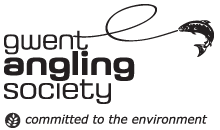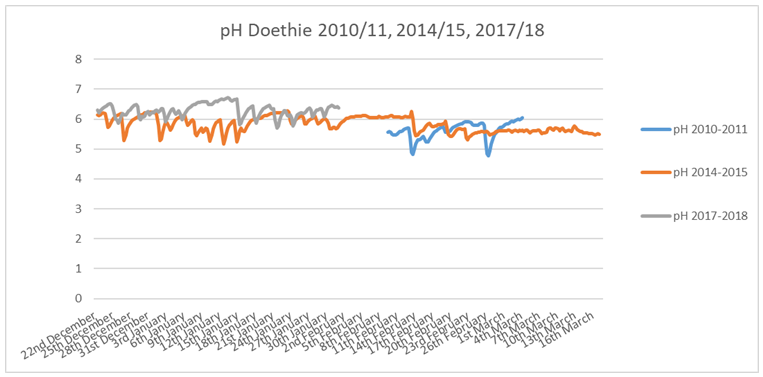
An Update on the Doethie In-River Sand Liming and Leader & Forestry Gully Liming Pilot Project
Summary
This paper is an update on a project designed to assess the benefits of adding crushed limestone to ameliorate the effects of episodic acidification, exacerbated by historic conifer forest, on the Doethie tributary of the upper river Tywi in Carmarthenshire. This liming programme began in 2010 with the annual addition of in-river limestone sand to strategic sites along the catchment. The paper briefly outlines the ecological improvements achieved by this action but in particular, it describes the benefits over the last two years of additional work carried out by the Trust in a Leader + funded pilot project to evaluate a new strategy involving forestry road gully liming.
The results of some of the evaluation work to date are described and indicate that significant improvements have been achieved in river water quality and pH. It appears that this is leading also to improvements in river invertebrate populations and in the numbers of juvenile salmonids present. This bodes well for the future recovery of the sub-catchment and the upper reaches of the Tywi mainstem. The paper ends with a summary of on-going and proposed future plans to complete the two-year pilot and to further enhance riverine ecology and the fishery potential of the Tywi in the years ahead.
Background
The addition of in-river limestone sand to 9 sites on the catchment has been on-going since 2010 but because of the lack of access to the riverbank, it was decided not only to increase the dosages of sand at existing sites but also to apply lime to forestry road gullies within the Cwm Berwyn conifer forest. Acidified run-off flowing downhill from the forest enters these roadside gullies and has to pass through culverts before flowing along forest ditches to reach the river with devastating effects on stream invertebrates, salmonid fish and river birds etc. for many miles downstream. With support from Afonydd Cymru, Natural Resources Wales (NRW) staff, Dŵr Cymru/ Welsh Water (DCWW) and crucial Leader+ funding the West Wales Rivers Trust has embarked on a 2-year pilot project involving the application of 500 tonnes of crushed limestone to selected culvert sites along roadside gullies in the forest.
Observations on the results of recent invertebrate analysis
Invertebrate sampling data obtained recently (June 2018), as a result of a brief interim analysis to provide a snap-shot of the outcomes of liming to ameliorate acid episode effects, shows what we consider to be a significant indication of improvement following the first year of forestry road gully liming. This was the presence of good numbers of Baetis (Olive) nymphs in 2018 at both of the uppermost sampling sites near to the source of the Doethie (38 individuals in the Doethie sample and 101 on Nant Esgair Wynt). This is the first time for many years that any of these acid-sensitive nymphs have been found this high up the Doethie headstreams within the Cwm Berwyn Forest and is, we believe, a clear sign of successful amelioration of acidification/aluminium toxicity which now appears to be decreasing here.
Spot pH testing of river water in late June 2018 at these sites seem to confirm this with readings averaging pH 6.6 recorded for the Doethie and pH 6.8 average recorded for its uppermost tributary Nant Esgair Wynt. Although the analysis involved in these quick check samples is limited, the presence for the first time of these Baetis nymph insects is a significant key indicator for us not only because it is known that they are unable to survive acid episode conditions but also because they form an important component of the diet of young salmonids. Indeed young salmonids were also observed at these sites.
Comparisons of more recent invertebrate data with earlier years has shown a gradual improvement in the invertebrate life present in the sub-catchment. (See kick sample results in the table below).
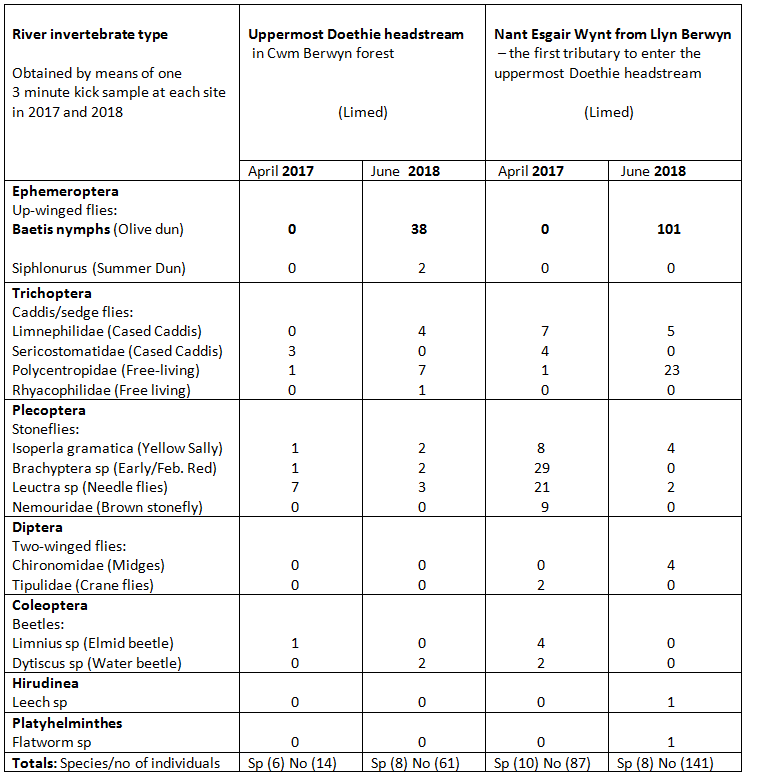
As well as an increase in the numbers of such acid sensitive individuals another indicator of recovery from acidification would be an increase in the overall diversity of invertebrate species. These latest kick samples indicated a slight increase in the number of the invertebrate groups present on the uppermost Doethie headstream.
There were indications also that Caddis flies (Trichoptera) were also increasing in numbers at both sites with many cased caddis larvae visible on the riverbed yet not necessarily ending up in kick-net samples as they are not always easy to dislodge from riverbed stones. Although stonefly (Plecoptera) numbers were lower than in the 2017 samples this was not unexpected because the 2018 samples were taken later in the year and one would expect such seasonal differences in the numbers of these insects at both sites. Also stoneflies in particular are pretty tolerant of acid conditions and we would expect them to be present here in good numbers at the appropriate times. We also know however that as a group they are often the most sensitive to pesticides that may enter watercourses so we will be monitoring them carefully.
Although some invertebrate groups appeared to indicate a reduction in the numbers of individuals this would have been expected because of seasonal variations already mentioned. Further kick sampling and analysis at these two sites will again be carried out later this summer/autumn after higher flows and at a time when many of the eggs/tiny nymphs missed in June will have hatched and grown to a size that can be collected and identified. The results, later this summer, of other more detailed and on-going analysis of invertebrate samples collected in April 2018 at other Doethie sites will hopefully provide further confirmation that better water quality has been accompanied by an overall improvement in diversity and river ecology.
It should be noted of course that the above data represents only a single 3-minute kick sample at each site during which some invertebrate species present in the stream can be missed. The apparent absence of a particular species or group at any one of the sites does not, therefore, mean that it not present there at all. There is no doubt however about the very pleasing presence in both 2018 samples of the acid-sensitive Baetis nymphs indicating better water quality at both stream sites. It is pleasing also to note the increase in the total numbers of invertebrate individuals present in 2018 compared with 2017 thus indicating an increase in total biomass and productivity at these sites with more potential food for juvenile salmonids and river birds such as dippers and wagtails.
Further evidence of improvements in pH/water quality.

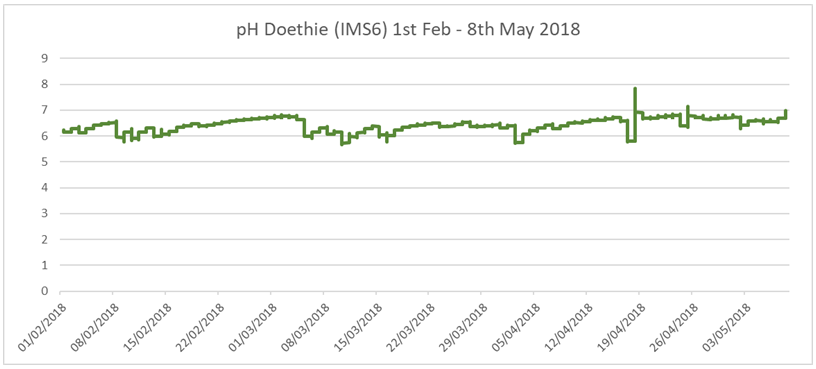
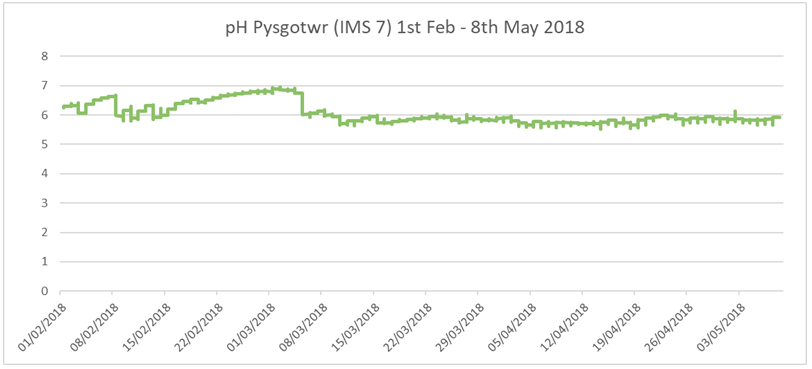
Above: pH data from the Pysgotwr (above the confluence with the Doethie) from the 1st February to the 8th May, 2018
The graphs above illustrate the pH ranges recorded by remote data loggers in the lower Doethie from 2010 to 2018. It can be seen that while on-going in-river sand liming has seen an improvement in pH and a reduction in the extent of acid episodes since 2010 there has been a further significant increase in pH since forestry gully liming began in late 2017 as part of the Leader + liming pilot. There has been an increase of a whole pH unit over the last couple of years. This continuous monitoring of river pH lower down the catchment by NRW has confirmed that pH mostly remained between pH6 and pH7 from October 2017 to May 2018 with the pH never dropping below 5.7 (pH values below 5.5 are known to have negative effects on the health of young salmonids and river invertebrates). This was over a period of exceptionally wet 2017/2018 autumn, winter and spring weather when, in the absence of liming, episodic acidification effects from conifer forest drainage could have been especially severe.

Above: Photo of 2 drains merging, one limed (light brown ditch entering from the left) and one unlimed (dark brown heavily peat stained ditch to the right).
Juvenile salmonid fish surveys – comparison of 2016/2017 juvenile salmonid fish data
NRW juvenile salmonid surveys in summer 2016 indicated that the Doethie was one of the very few river sites in Wales demonstrating a positive trend in salmon fry numbers although admittedly the numbers were still low. Further improvement was recorded in 2017 and the results of juvenile fish surveys (salmon and trout including sea trout) on the lower reaches of the Doethie and its Pysgotwr tributary (both limed) carried out by fisheries staff in summer 2016 and 2017 are shown in the table below:

The above “fully quantitative data” is the result of the most detailed assessment of juvenile fish by electrofishing methods to give reliable scientific estimates and comparisons of numbers present per 100m2 of the stream. The figures indicate a significant overall improvement in juvenile fish numbers in 2017 compared with 2016 in the lower reaches of both rivers just upstream of their confluence.
While the 2017 classification grades are an improvement there is still a way to go – see National Classification grade descriptors in the table below:

Less rigorous semi-quantitative survey estimates (providing data not necessarily as accurate as the fully quantitative estimates above) indicated juvenile trout to be present above the Fronfraith fall on the Doethie, and above the Pwll Uffern falls on its Pysgotwr tributary, but no salmon here on either stream. Salmon and sea trout are able, however, to negotiate the Doethie fall in suitable flows. Trout numbers on the Pysgotwr were higher than on the Doethie but would have been non-migratory trout only as returning adult sea trout and salmon are unable to negotiate the impassable falls at Pwll Uffern.
The Doethie is considered still to be heavily impacted by forestry exacerbated acidification and the Leader + pilot is intended to improve the liming regime on the sub-catchment to achieve a better amelioration of acid episode effects after heavy rain. The reaches furthest upstream of the falls on both rivers would be more impacted by closeness to forestry effects. Also by being within, or closer to, chemical mixing zones downstream of lime application sites it is possible that they could be subject to greater fluctuations in pH, water quality and aluminium toxicity. It is for these reasons that lime is applied as high up the two rivers as possible so that benefits occurring downstream from liming can be as extensive as is possible. Also by treating the gullies and ditches in the forest with lime the acidity and aluminium toxicity is reduced before reaching the rivers so that mixing zone effects downstream are significantly reduced.
Future benefits for salmon and sea trout
NRW has projected the likely future benefits for juvenile salmon and sea trout production in the limed Doethie/Pysgotwr sub-catchment. Their workings for this catchment assessment are based on juvenile fish data and Habscore (habitat assessment modelling) values from summer 2017. By comparing actual numbers with the very best in fish numbers that can theoretically be expected in the sub-catchment, fisheries managers calculated the theoretical room for improvement in the numbers of salmon and sea trout smolts that might be produced annually. It is presumed that the “expected” figures quoted assume that the much improved water quality/pH values in the sub-catchment recorded by the lower Doethie continuous monitor between October 2017 and February 2018, following the combined in-river sand and Leader + gully liming strategy implemented in October 2017, can be maintained in future.
We have prepared below a table summarising the figures obtained for smolt production for salmon and sea trout from the NRW data. We have also calculated corresponding expected annual numbers of adult returning salmon and sea trout to the catchment. These are based on the assumption adopted by NRW that smolt to adult survival rate is 3% in salmon. While the survival rate for sewin is unknown it has been considered in the past to be higher than for salmon and possibly as much as 15%. However, because of the crash in sea trout numbers in recent years we have adopted in the table the questionably low 3% figure for them also.
The figures in the table suggest that continued improvements in water quality in the Doethie/Pysgotwr could lead to returning adult salmon numbers in the sub-catchment being almost doubled with sea trout numbers more than trebled. This would be a real improvement with 11, 184 sea trout smolts and 13,633 salmon smolts produced and with estimated possible future adult sea trout returners numbering 336 and salmon returners numbering 408.
While accepting perhaps that juvenile salmon might be a little more tolerant of serious acidification than trout, the view of Trust volunteers involved in this project is that the sub-catchment should have an even greater potential for producing sea trout, when compared with salmon, than the figures in the table would suggest. Experience over many years of fish runs on the sub-catchment, including earlier times when fish numbers were relatively very high, indicates that although good numbers of salmon spawned in the Doethie it was regarded primarily as a sea trout river. While salmon were common in the lower Doethie and Pysgotwr, the middle and upper Doethie was recognised by anglers as being mainly a sea trout river.
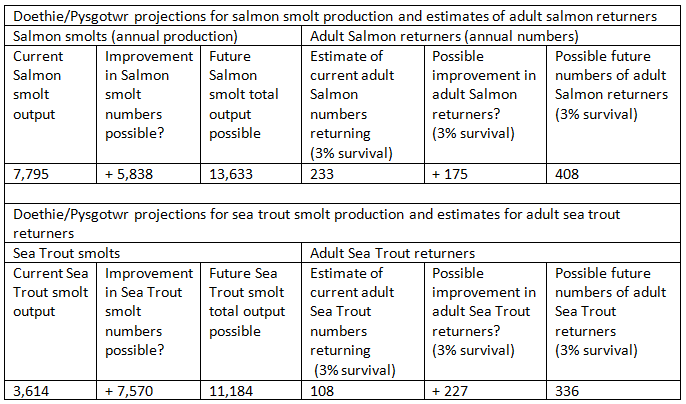
Had we chosen in the table above to use the higher figure of 15% survival from smolts to returning adults for sea trout and also considered the fact that sewin are multiple spawners, the resulting revised figures would offer an even more optimistic view for sea trout recovery. We are, however, very concerned about the lower numbers of adult sea trout presently returning to spawn in Welsh rivers. The fall in numbers of adult breeding sewin and salmon in recent years will not help the recovery of stocks on the Doethie. Possible high juvenile fish mortality associated with very low flows and high temperatures such as those we experienced during this summer`s drought will not help either.
The workings above do however provide us with a useful theoretical prediction of future salmonid productivity based on the situation that has existed in the Doethie in more recent years, when electrofishing surveys have shown juvenile sea trout numbers to be lower than for salmon. They also provide a stimulus for thought about the Doethie`s potential to produce salmon and sea trout if we can overcome water quality issues long term and expand on habitat initiatives such as the successful broadleaf tree planting programme, pioneered by the Trust`s project officer, that has already taken place here. Throughout the winter period of 2015 – 2016 a total of 2.700 native broadleaf trees (predominantly rowan, hawthorn, birch, willow and alder) were planted at strategic sites along the banks of the Doethie. It was hoped that the trees would facilitate dappled shading throughout the catchment, adding leaf litter as food for invertebrates, and stabilise eroding riverbanks where needed. This was undertaken as a pilot project with the aid of the Woodland Trust. There has been a remarkable success rate – up to 98% survival at the majority of sites, and it is now planned to plant further upland tributaries for the same environmental gains. It will be important for the Trust to work with NRW forestry staff to further expand on this work and create effective broadleaf riparian buffer zones within the Doethie/Cwm Berwyn conifer forest.
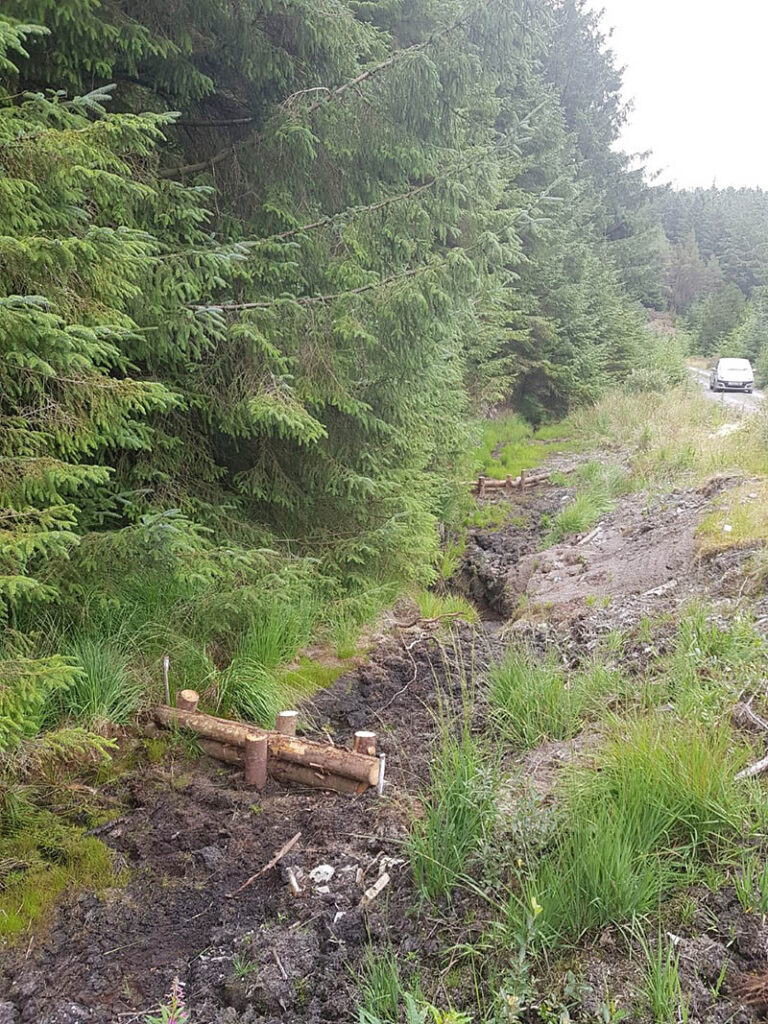
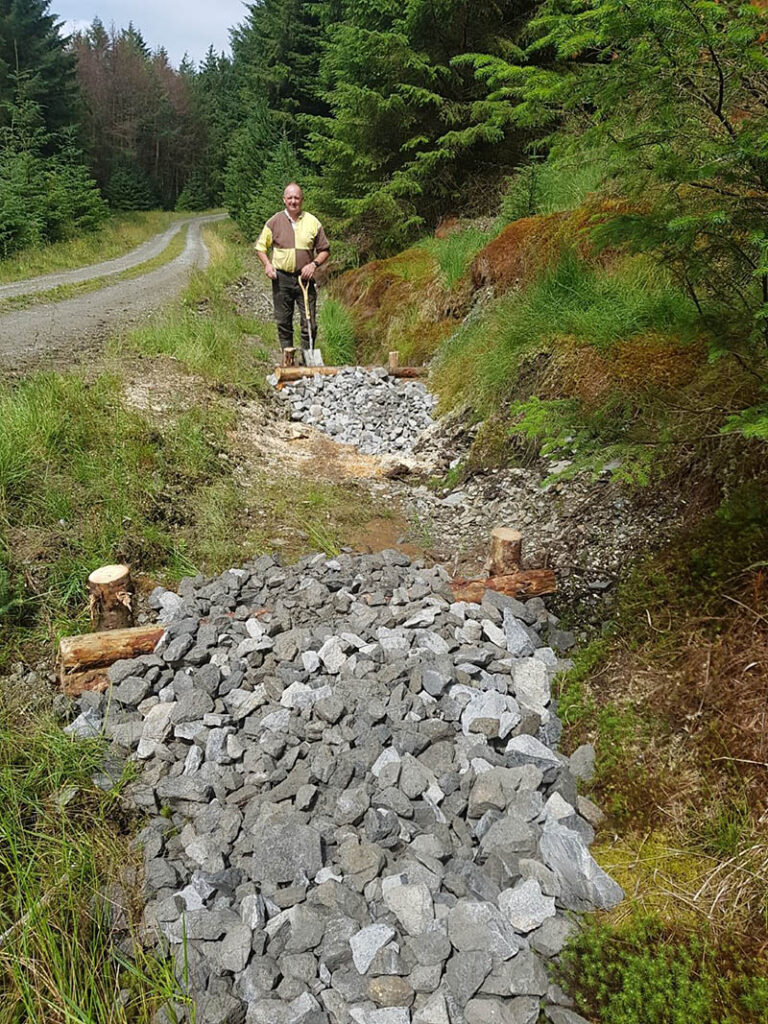
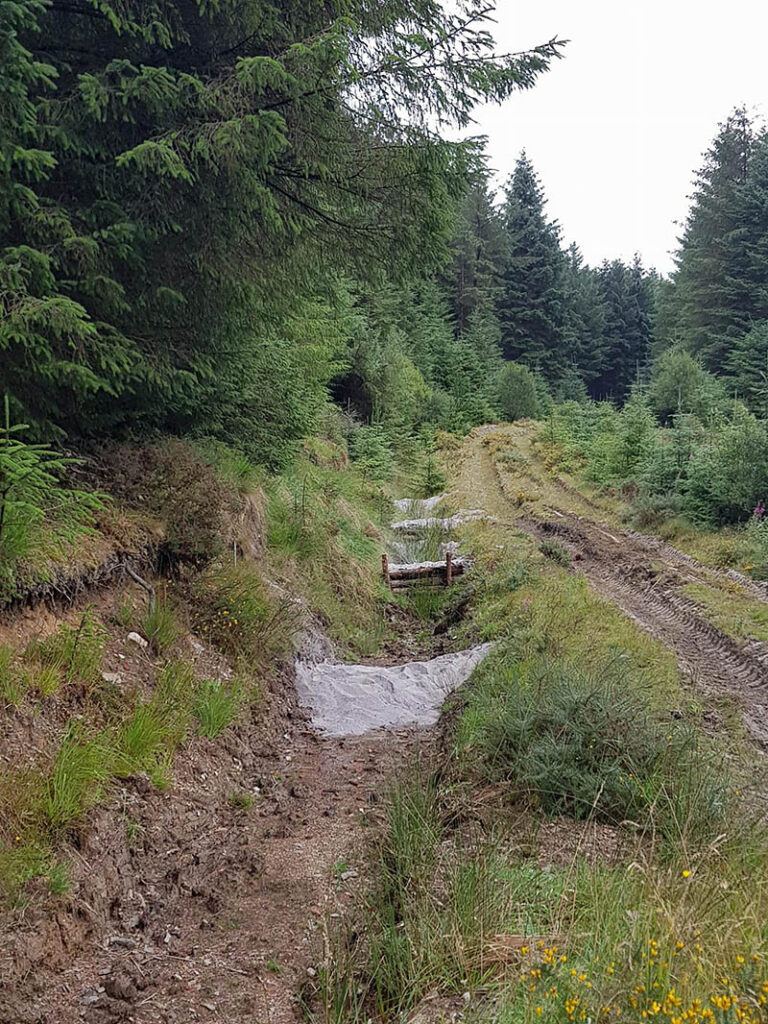
On-going and future plans
The on-going in-river sand liming of the Doethie and its Pysgotwr tributary will continue up to three times a year for the foreseeable future. A total of 58 tonnes were applied in April 2018 to 10 sites and it was intended to repeat this in July with a further larger application of 84 tonnes available in October to protect juvenile fish and invertebrates over what is often a very wet winter period characterised by significant acid episodes. In-river sand is best applied in good flows after rain to aid its downstream distribution along the river channel. With the rivers so very low this summer we were pleased when some rain eventually arrived just in time to allow a reduced July sand lime application of just 21 tonnes. In view of the success we have achieved in neutralising acid episodes in recent months, this reduced July dosage will hopefully have been enough and continuous remote monitoring of water quality will indicate if satisfactory pH values have still be maintained. The larger autumn application due in October will hopefully protect salmonid smolts that are known to be particularly vulnerable to acid and aluminium toxicity when silvering up before migrating to sea in the spring.
The Leader + funded forestry road gully liming was able to go ahead fully as planned in spite of the dry weather as the lime would be washed into the streams only when high flows returned. A total of 250 tonnes of lime was applied to gullies and culverts in the three pilots areas in 2017 and by late July 2018 a further 250 tonnes had been applied to complete the 2 year dosage for the Leader + pilot study. A total of over 25 log and stone dams were installed in the Pilot 1 gullies to help control wash out of lime and retain sufficient quantities in the gullies to provide long term protection to the receiving watercourse. We have already learned much about the finer details of effective gully liming during the course of the pilot and will be able to put this to good use as required in future years.
Careful monitoring of water quality, invertebrate and juvenile fish populations, with support from NRW fisheries and ecology teams and an MSc student thesis, will provide data that will enable the Trust to decide the details of on-going liming beyond 2018. As already mentioned the Trust will also continue to work with NRW forestry staff to further improve riverine habitat by creating effective riparian buffer zones planted with broadleaf trees where conifers are harvested.
A positive future for the Doethie is further secured as a result of funding that the Trust has received from DCWW. An agreement was reached this year between NRW and DCWW as to the amount of funding that would be provided to continue the Doethie restoration project for the next 10 years. As a result £250,000 has been donated to the WWRT in June this year. This fund will be carefully managed to secure the continued restoration of the Doethie but some will also be used as match funding for restoration projects elsewhere in the Tywi catchment. In this way we intend to extend the Trust’s area of activity with the wider benefits for river ecology and fisheries.
At this moment in time we are more confident than ever that the Leader + pilot project will prove a success and provide us with the knowhow to enhance water quality in acidified streams for the benefit of salmonid fish and the wider riverine environment.
Written and compiled by Brian Jones, Caroline Orr and Frank Jones.

